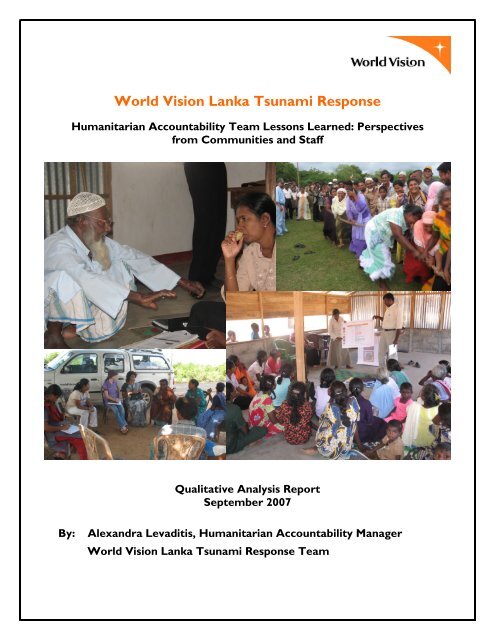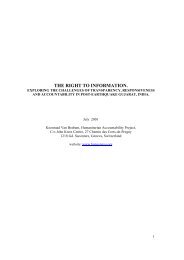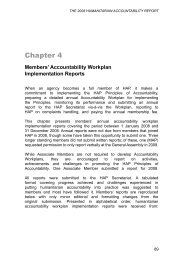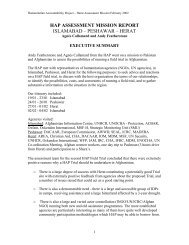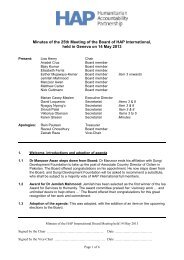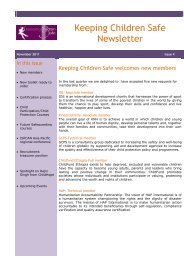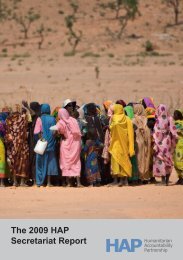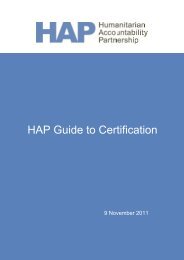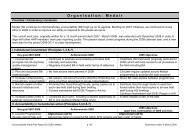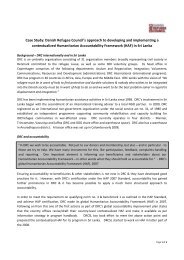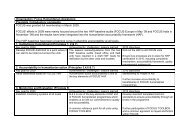Humanitarian Accountability Team Lessons ... - HAP International
Humanitarian Accountability Team Lessons ... - HAP International
Humanitarian Accountability Team Lessons ... - HAP International
You also want an ePaper? Increase the reach of your titles
YUMPU automatically turns print PDFs into web optimized ePapers that Google loves.
World Vision Lanka Tsunami Response<br />
<strong>Humanitarian</strong> <strong>Accountability</strong> <strong>Team</strong> <strong>Lessons</strong> Learned: Perspectives<br />
from Communities and Staff<br />
Qualitative Analysis Report<br />
September 2007<br />
By:<br />
Alexandra Levaditis, <strong>Humanitarian</strong> <strong>Accountability</strong> Manager<br />
World Vision Lanka Tsunami Response <strong>Team</strong>
Glossary Of Acronyms<br />
CAG<br />
CBO<br />
DME<br />
EOP<br />
FGD<br />
GS<br />
HAT<br />
INGO<br />
LCP<br />
LTRT<br />
NGO<br />
WV<br />
Community Action Group (often used interchangeably with CBO for LTRT supported<br />
community organizations at housing sites)<br />
Community Based Organization<br />
Design, Monitoring & Evaluation<br />
End-of-Program or Project<br />
Focus Group Discussion<br />
Grama Sevaka (local village-level government authority)<br />
<strong>Humanitarian</strong> <strong>Accountability</strong> <strong>Team</strong><br />
<strong>International</strong> Non-Governmental Organization<br />
Local Capacities for Peace<br />
Lanka Tsunami Response <strong>Team</strong><br />
Non-Governmental Organization<br />
World Vision
World Vision LTRT: <strong>Humanitarian</strong> <strong>Accountability</strong> <strong>Team</strong><br />
<strong>Lessons</strong> Learned Analysis Report<br />
Page 3/26<br />
Acknowledgements<br />
I would like to thank all staff that served with the <strong>Humanitarian</strong> <strong>Accountability</strong> <strong>Team</strong> since its inception<br />
for their tireless efforts to ensure the LTRT program was accountable to those we served. Their<br />
contribution will be remembered by the families whose lives they touched.<br />
A big thank you to the following teams that facilitated the community focus group discussions:<br />
Kalutara team – Mavis Kuruwitage, Viraj Wahalatantri and myself<br />
Batticaloa team – Jo-Hannah Lavey, Rebecca Owen, Diluksion Francis and Jaya Rathamohan<br />
Jaffna team – Goldan Gomara and V. Kathiramalai<br />
….And the participants of the staff focus group discussion and interviews:<br />
Romesh Fernando, Viraj Wahalatantri, Mavis Kuruwitage, Bandara Hurikaduwa, Lakshman Perera,<br />
Josephine Pillai, Diluksion Francis, Gowry, V. Kathiramalai, Rebecca Owen and Kevin Mackey.<br />
A special note of appreciation to Sajilu Kamwendo, DME Manager for his support in the development<br />
and analysis of survey tools, the facilitation of the staff focus group discussion and key informant<br />
interviews and review and editing of this report and to Nishan Dissanayake for serving as the Recorder.<br />
A final word of thanks to all the Community Mobilizers who served as the first point of contact for<br />
communities and whose efforts often went unnoticed.<br />
Alexandra Levaditis<br />
Manager, <strong>Humanitarian</strong> <strong>Accountability</strong> <strong>Team</strong><br />
World Vision Lanka Tsunami Response
World Vision LTRT: <strong>Humanitarian</strong> <strong>Accountability</strong> <strong>Team</strong><br />
<strong>Lessons</strong> Learned Analysis Report<br />
Page 4/26<br />
Table of Contents<br />
GLOSSARY OF ACRONYMS...................................................................................................... 2<br />
ACKNOWLEDGEMENTS ........................................................................................................... 3<br />
TABLE OF CONTENTS .............................................................................................................. 3<br />
1. EXECUTIVE SUMMARY ......................................................................................................... 3<br />
1.1 COMMUNITY FOCUS GROUP DISCUSSIONS.........................................................................................................3<br />
1.2 STAFF FOCUS GROUP DISCUSSIONS AND KEY INFORMANT INTERVIEWS .......................................................3<br />
2. INTRODUCTION..................................................................................................................... 3<br />
3. COMMUNITY FOCUS GROUP DISCUSSIONS .................................................................. 3<br />
3.1 METHODOLOGY.......................................................................................................................................................3<br />
3.2 SURVEY FINDINGS.....................................................................................................................................................3<br />
4. STAFF FOCUS GROUP DISCUSSION AND KEY INFORMANT INTERVIEWS............. 3<br />
4.1 METHODOLOGY.......................................................................................................................................................3<br />
4.2 SURVEY FINDINGS.....................................................................................................................................................3<br />
5. CONCLUSION.......................................................................................................................... 3<br />
APPENDIX 1: QUANTITATIVE DATA..................................................................................... 3<br />
APPENDIX 2: FGD GUIDELINES-COMMUNITIES........ERROR! BOOKMARK NOT DEFINED.<br />
APPENDIX 3: FGD GUIDELINES-STAFF ........................ERROR! BOOKMARK NOT DEFINED.
World Vision LTRT: <strong>Humanitarian</strong> <strong>Accountability</strong> <strong>Team</strong><br />
<strong>Lessons</strong> Learned Analysis Report<br />
Page 5/26<br />
1. Executive Summary<br />
1.1 Community Focus Group Discussions<br />
During September 2007, the <strong>Humanitarian</strong> <strong>Accountability</strong> <strong>Team</strong> (HAT) conducted 10 focus group<br />
discussions (FGDs) in three operational districts to evaluate the impact of its activities. The qualitative<br />
survey was based on FGDs with permanent housing recipients, using structured discussion guides that<br />
explored four major themes:<br />
1. Application of skills and knowledge acquired through training<br />
2. Forms of information sharing and consultation<br />
3. Viability and effectiveness of community organizations<br />
4. Improved relations in community<br />
The following key points emerged from the analysis:<br />
1. There was evidence in all districts that the skills acquired through trainings are being used by<br />
community members.<br />
2. HAT trainings were recognized as well-organized and executed.<br />
3. Other trainings aimed at livelihoods especially but also other topics such as health, whether<br />
conducted by World Vision or other organizations, were often easier to recall than HAT<br />
trainings.<br />
4. Different levels of understanding within the community made application of some trainings,<br />
especially LCP, more difficult.<br />
5. Communities, including vulnerable groups, felt they were adequately consulted by World Vision.<br />
6. Community meetings were the preferred mode of sharing and receiving information.<br />
7. Community Action Groups (or CBOs) have been formed at all sites with varying degrees of<br />
success to date. Some CAGs were found to be proactive and enjoyed community support,<br />
others were taking initial steps at leadership with mixed support while one CAG had been<br />
disbanded.<br />
8. Where communities are less familiar with each other, community organizations are struggling<br />
more to define and undertake their role.<br />
9. World Vision played a vital role in representing community interests to government and other<br />
stakeholders, building trust especially between communities and Stakeholder Representatives.<br />
This confidence must shift to CAGs if they are to take over long-term management of sites.<br />
10. Additional support was requested to increase the likelihood of the long-term viability of<br />
Community Action Groups.<br />
11. Relations amongst community members had improved in all cases from the time that families<br />
first moved into their new homes. Peacebuilding activities contributed to this by bringing people<br />
together and providing them with the opportunity to get to know each other and establish<br />
relationships.<br />
12. The level of positive impact the CAG was perceived to have on improving relations ran parallel<br />
to people’s perception of the capacity of the CAG generally.<br />
13. Community infrastructure played an important role for many by providing the space to meet.
World Vision LTRT: <strong>Humanitarian</strong> <strong>Accountability</strong> <strong>Team</strong><br />
<strong>Lessons</strong> Learned Analysis Report<br />
Page 6/26<br />
14. Proximity of living space was raised in Jaffna and Batticaloa as having both positive and negative<br />
consequences on community relations. Interestingly, where the community was living in<br />
attached townhouses in Kalutara, space was not mentioned except in the context of the impact<br />
of the community hall.<br />
1.2 Staff Focus Group Discussions and Key Informant Interviews<br />
During September 2007, the LTRT DME unit conducted a focus group discussion with HAT field staff to<br />
contribute to the evaluation of HAT activities and also structure. The qualitative survey used a semistructured<br />
discussion guide and two key informant interviews that explored four major themes:<br />
1. Application of skills and knowledge acquired through training,<br />
2. Forms of information sharing and consultation<br />
3. Improved relations in community<br />
4. Organizational staff support<br />
The following key points emerged from the analysis:<br />
1. Community accountability training, Local Capacities for Peace TOT and Advocacy training were<br />
viewed as the three most beneficial trainings HAT field staff received to help them work with<br />
communities.<br />
2. HAT training methods were innovative and interactive which was helpful in encouraging<br />
participation and learning.<br />
3. Similar to the views presented by communities, HAT field staff agreed that community meetings<br />
were the most effective way of community consultation and information sharing.<br />
4. HAT activities contributed to improving relations between community members.<br />
5. Staff found the HAT reporting structure supportive of their activities. However, they were<br />
sometimes overwhelmed by multiple requests from different HAT Colombo staff.
World Vision LTRT: <strong>Humanitarian</strong> <strong>Accountability</strong> <strong>Team</strong><br />
<strong>Lessons</strong> Learned Analysis Report<br />
Page 7/26<br />
2. Introduction<br />
The unprecedented humanitarian response to the tsunami in Sri Lanka required a high degree of<br />
coordination with other agencies, government and most importantly recipient communities. This posed<br />
a challenge to many agencies which was highlighted in a wide-scale evaluation of the Sri Lanka tsunami<br />
response conducted by the Tsunami Evaluation Coalition.<br />
“The lack of accountability to aid recipients is an acknowledged weakness of the international relief system. The<br />
recipients surveyed for the TEC studies reported that they were not adequately consulted. Furthermore, the<br />
studies found that there were large information gaps between agencies and the communities they were serving.” 1<br />
The size and complexity of the program necessitated a far greater awareness of community issues/needs<br />
and greater engagement with communities if its deliverables were to be responsive, appropriate and<br />
timely. The <strong>Humanitarian</strong> <strong>Accountability</strong> <strong>Team</strong> (HAT) was established by the Lanka Tsunami Response<br />
<strong>Team</strong> (LTRT) in May 2005 to promote program accountability and integrate Do No Harm principles by<br />
providing the human resources and tools for effective community engagement, advocacy and<br />
coordination with I/NGOs and government. The team was made operational through both Colombobased<br />
technical advisors and implementing field staff.<br />
While the activities of HAT were largely intertwined with other program sectors, in FY2007 HAT<br />
established itself as an independent program sector (Civil Society) with an independent set of activities<br />
that were self-directed and focused on strengthening the knowledge and capacity of communities<br />
towards self-reliance, ensuring a responsible withdrawal from communities and the sustainability of<br />
program inputs. HAT activities largely fell within three main components:<br />
1. Community Engagement/<strong>Accountability</strong><br />
2. Conflict Sensitivity and Peacebuilding<br />
3. Liaison and Advocacy<br />
HAT was the first team of its kind within World Vision <strong>International</strong>. This report seeks to evaluate the<br />
impact of HAT activities, learn from successes and lessons and provide guidance to those starting to<br />
implement accountability both within Sri Lanka and outside. It highlights the findings of focus group<br />
discussions (FGDs) with permanent housing beneficiaries in Kalutara, Batticaloa and Jaffna. These<br />
beneficiaries were targeted for this study as participants in the full range of HAT activities who would<br />
have the ability to best assess them. The report also separately highlights findings from a FGD held with<br />
HAT field staff and two key informant interviews focusing on similar issues in addition to the team’s<br />
organizational structure.<br />
Government and inter-agency coordination, a key function of HAT, was not explored in this survey for<br />
two reasons: 1) A separate quantitative survey was conducted earlier in the year exclusively on the<br />
effectiveness of LTRT coordination efforts; and 2) While coordination was aimed at assisting and<br />
supporting beneficiary communities, activities were not focused directly on them. 2<br />
1<br />
Tsunami Evaluation Coalition (TEC): Initial Findings, p.10.<br />
2<br />
To receive a copy of the findings of this survey, please e-mail Alexandra Levaditis at Alexandra_Levaditis@wvi.org or Sajilu Kamwendo at<br />
Sajilu_Kamwendo@wvi.org.
Table 1: HAT Logframe<br />
Project Goal Outcomes Outputs Activities<br />
Foster and<br />
promote<br />
community<br />
sustainability by<br />
integrating<br />
accountability to<br />
stakeholders<br />
Tsunami-affected<br />
communities are active in<br />
determining their own<br />
future through engagement<br />
and local community<br />
institution strengthening<br />
Beneficiary needs identified and<br />
acted upon<br />
Community-Based Organizations<br />
(CBOs) and other community<br />
structures established or<br />
strengthened<br />
Beneficiary selection and verification<br />
Community consultation (including targeting of gender and disabilities)<br />
Disseminate operational exit plans and develop/support district strategies<br />
Community engagement training and coaching<br />
Resource material development (including best practice)<br />
Peace strengthened in local<br />
communities through<br />
conflict sensitivity<br />
Do No Harm principles applied to<br />
reduce tensions and support<br />
connectors in local communities<br />
Conflict sensitivity assessments<br />
Conflict sensitivity training for WV staff and selected stakeholders<br />
Support implementation of agreed assessment recommendations<br />
Targeted peacebuilding that<br />
supports Local Capacities for<br />
Peace (LCP)/Do No Harm<br />
Pilot child/youth peace activities<br />
Develop networks with agencies engaged in conflict sensitive activities<br />
Alliances with inter-agency<br />
and government<br />
stakeholders are fostered to<br />
promote accountability to<br />
communities<br />
Partnerships established to better<br />
meet the needs of communities<br />
Targeted advocacy initiatives<br />
Coordination and participate in inter-agency forums/networking<br />
Develop coordination materials (DIS, etc)<br />
UN OCHA (HIC) mapping project<br />
Liaise with government and local authorities<br />
Develop advocacy strategy (key issues) and document best practice<br />
Advocacy campaigns including research<br />
Advocacy training and coaching
Table 2: Housing Beneficiaries<br />
District<br />
Number of Houses Constructed by LTRT*<br />
Ampara 354<br />
Batticaloa 269<br />
Galle 110<br />
Hambantota 110<br />
Jaffna 121<br />
Kalutara 173<br />
Matara 157<br />
Mullaitivu 500<br />
Trincomalee 100<br />
Total 1894<br />
*As of September 2007. Additional houses are newly under construction in Trincomalee district which are not<br />
reflected here.
World Vision LTRT: <strong>Humanitarian</strong> <strong>Accountability</strong> <strong>Team</strong><br />
<strong>Lessons</strong> Learned Analysis Report<br />
Page 10/26<br />
3. Community Focus Group Discussions<br />
3.1 Methodology<br />
3.1.1.Survey tool<br />
The qualitative survey utilized a structured focus group discussion (FGD) guide 3 , based on four themes:<br />
1) Application of skills and knowledge acquired through HAT training; 2) Forms of information sharing<br />
and consultation; 3) Viability and effectiveness of community organizations; and 4) Improved relations in<br />
the community. These themes were selected as representative of core HAT activities with communities<br />
(see Logframe in Table 1).<br />
3.1.2 Survey description<br />
Three teams were deployed to conduct focus group discussions with community members according to<br />
pre-developed scripts and reporting forms. Each team was assigned to a district based on familiarity<br />
with that district and selected sites. The number of team members varied slightly from district to<br />
district based on availability of staff. All teams consisted of LTRT staff (mostly HAT staff) – no external<br />
staff or consultants were used.<br />
Batticaloa – 2 facilitators (1 for 2 focus groups), 1 interpreter/observer, 1 note taker<br />
Kalutara – 1 facilitator, 1 interpreter/observer, 1 note taker<br />
Jaffna – 1 facilitator, 1 note taker (no interpreter required)<br />
Focus group participants consisted exclusively of World Vision housing beneficiaries as they were the<br />
target of the majority of HAT’s activities from the inception of the department.<br />
Separate focus group discussions were held with men and women. In one case in Kalutara, a mixed<br />
focus group discussion was held due to the small number of participants available (only 11 households at<br />
that site). A focus group discussion was held with youth in Jaffna because many of HAT’s activities at<br />
that site were implemented through the Youth Association or designed to strengthen the association.<br />
Focus group discussions were not, unfortunately held with children due to serious time constraints in<br />
developing the survey tool and completing the evaluation process.<br />
Data collection and field-level analysis took place from 19 – 25 September 2007.<br />
3.1.3 Data collection<br />
The target group selected to participate in data collection consisted exclusively of beneficiaries of World<br />
Vision LTRT reconstructed permanent houses. The reason for this narrow focus was that the range of<br />
activities reflected in the HAT logframe were concentrated on this group of beneficiaries throughout the<br />
program.<br />
FGD participants were then randomly selected from among World Vision LTRT permanent housing<br />
beneficiaries using systematic interval sampling. The sampling frame was restricted to WV LTRT<br />
permanent shelter beneficiaries for several reasons:<br />
• The range of HAT activities could only be reflected at housing sites where there was resettlement<br />
of beneficiaries to new locations from where they previously resided pre-tsunami. In locations<br />
3<br />
See Appendix Two for a copy of the discussion guide.
World Vision LTRT: <strong>Humanitarian</strong> <strong>Accountability</strong> <strong>Team</strong><br />
<strong>Lessons</strong> Learned Analysis Report<br />
Page 11/26<br />
where World Vision reconstructed houses on beneficiary’s own land, activities such as CBO<br />
strengthening and peacebuilding was generally not undertaken under the assumption that preexisting<br />
institutions and relationships would be resumed.<br />
• Because of the contextual diversity of Sri Lanka across the three operating zones (especially in<br />
relation to the conflict), it was important that each zone be represented.<br />
• Where a district was selected for data collection, all housing sites within that district participated in<br />
focus group discussions. The exception to this was Batticaloa where only two of three sites were<br />
surveyed. The third site was not included because of time restrictions on data collection.<br />
Table 3: FGD Selection<br />
Zone District Housing Sites FGDs Held Rationale for Selection<br />
South<br />
Kalutara<br />
Sub-Total South<br />
East<br />
Batticaloa<br />
Sub-Total East<br />
Dhahami Pura*<br />
Athukorala<br />
Gama**<br />
Paliyadithona<br />
Kaluwankerny<br />
2 (men, women)<br />
1 (mixed men &<br />
women<br />
3 FGDs<br />
2 (men, women)<br />
2 (men, women)<br />
4 FGDs<br />
North Jaffna Potpathy 2 (men, women)<br />
Sub-Total North<br />
1 (youth)<br />
3 FGDs<br />
Total<br />
10 FGDs<br />
*Also known as Kontheru Parangiya Watta (KPW)<br />
**Also known as Monk’s Land<br />
Kalutara is one of four districts in the South.<br />
This is the only district to trial the community<br />
complaints/feedback mechanism for a significant<br />
period of time. This district was selected in the<br />
South to assess the impact of this mechanism<br />
(although it was not specifically probed).<br />
Batticaloa was selected from the three eastern<br />
districts because it is the only eastern district<br />
where there are resettlement sites as of Sept 07.<br />
Construction in Trincomalee and Ampara were<br />
on beneficiary’s own land.<br />
Jaffna was selected from the two northern<br />
districts because the Mullaitivu program was<br />
closed early in 2007. Data collection would also<br />
not have been possible in LTTE-controlled areas.<br />
Within each site selected for data collection, effort was made to restrict the number of participants to<br />
fifteen. To select participants, Community Mobilizers were asked to divide the total number of houses<br />
on the site by 15 (total number of participants) and then invite every fifteenth household.<br />
3.1.4 Data consolidation<br />
Note takers recorded responses and significant issues or themes raised directly into the script where<br />
space was provided for responses. Responses were then analyzed using analysis worksheets and<br />
reporting forms. The entire FGD facilitation team for the district participated in the analysis of data<br />
from that district, increasing the accuracy of the analysis. Secondary analysis was conducted in Colombo<br />
by three of the facilitators and the DM&E Manager. 4<br />
4<br />
The Kalutara facilitator and two Batticaloa facilitators participated in this. The Jaffna facilitator could not return to Colombo to participate.
World Vision LTRT: <strong>Humanitarian</strong> <strong>Accountability</strong> <strong>Team</strong><br />
<strong>Lessons</strong> Learned Analysis Report<br />
Page 12/26<br />
3.2 Survey Findings<br />
3.2.1 Application of skills and knowledge acquired through (HAT) training<br />
There was evidence in all districts that the skills acquired through trainings are being used by<br />
community members.<br />
A range of advocacy initiatives have been undertaken by communities where training was provided,<br />
including 5 :<br />
- Coordinating with government to solve garbage problem<br />
- Receiving identification cards that were lost during<br />
tsunami<br />
- Approaching local government (GS) on land rights issues<br />
- Petitioning government for bus service<br />
Youth in Jaffna indicated that trainings helped them manage<br />
the shelter site.<br />
Leadership training was used to facilitate the operation of a<br />
women’s society in Batticaloa.<br />
Community members participate in<br />
advocacy training.<br />
Training participants were able to share Local Capacities for Peace (LCP) concepts with other<br />
community members and training was noted as a good way to maintain good relations with<br />
neighbors.<br />
Participant Quotes:<br />
“I am now in a women’s society. I learned how to discuss things with members of the society, take<br />
decisions and how to lead members.” Woman – Batticaloa<br />
“After the training, we had more confidence to coordinate with the Pradeshiya Saba. The garbage<br />
problem was there always but it was only after we went to the training that we wrote a letter.” Man -<br />
Kalutara<br />
“After the training we were able to better understand our neighbors and how to deal with them. We<br />
maintain a good relationship.” Woman – Kalutara<br />
“We will be able to study the tension in our shelter site using the LCP tool.” Youth - Jaffna<br />
HAT trainings were recognized as well-organized and executed.<br />
Training venue was an important consideration for participants in the North and East due to access<br />
restrictions, security and other considerations. HAT staff considered these factors and sought to<br />
enable communities to participate through appropriate venue selection.<br />
In Batticaloa, residential trainings were preferred as participants indicated they could concentrate<br />
better. While not raised by participants, residential training was purposely planned by the<br />
Stakeholder Representative there because of the insecure environment within which participants<br />
5<br />
Advocacy training was not conducted in Jaffna due to travel restrictions as a result of the conflict.
World Vision LTRT: <strong>Humanitarian</strong> <strong>Accountability</strong> <strong>Team</strong><br />
<strong>Lessons</strong> Learned Analysis Report<br />
Page 13/26<br />
were living. 6 She felt it was important to remove them from a location where killings and<br />
kidnappings occurred on a daily basis to a location where they could relax and focus on learning.<br />
In all districts, trainings were recognized as well organized and facilitated.<br />
Participant Quotes:<br />
“The training is dependent on the resource person…I am satisfied with each training given by World<br />
Vision.” Woman – Batticaloa<br />
“The venue was selected after discussing it with us so as to suit our convenience and safety.” Youth -<br />
Jaffna<br />
“We were not able to participate in some trainings arranged by other NGOs because of the difficulties<br />
in access.” Youth - Jaffna<br />
Other trainings aimed at livelihoods especially but also other topics such as health, whether<br />
conducted by World Vision or other organizations, were often easier to recall than HAT<br />
trainings.<br />
When asked about World Vision trainings, participants in all districts usually first recalled trainings<br />
around livelihoods and secondly other topics such as health.<br />
Facilitators often had to prompt participants, asking specifically about individual trainings, to receive<br />
feedback on HAT trainings.<br />
Different levels of understanding within the community made application of some trainings,<br />
especially LCP, more difficult.<br />
HAT trainings were not provided to all members of a given community.<br />
In Kalutara and Jaffna, participants indicated that women attended trainings more than men.<br />
In Kalutara, the application of LCP training to the broader community was difficult because those<br />
that did not attend the training did not understand the new skills/knowledge that were being applied.<br />
Participant Quotes:<br />
“When I tried to apply the training, it caused more conflict. If everyone on the site gets the training, it<br />
would be more useful.” Man - Kalutara<br />
6<br />
The Stakeholder Representative was the HAT field representative in each district and served as the community’s focal point with World<br />
Vision. S/he was responsible for coordinating World Vision activities with beneficiaries and often with local government and other I/NGOs.
World Vision LTRT: <strong>Humanitarian</strong> <strong>Accountability</strong> <strong>Team</strong><br />
<strong>Lessons</strong> Learned Analysis Report<br />
Page 14/26<br />
3.2.2 Forms of information sharing and consultation<br />
Communities, including vulnerable groups, felt they were adequately consulted by World Vision.<br />
Community notice board in Kalutara<br />
contains key information about World<br />
Vision activity on the site.<br />
Forms of Information Sharing and Consultation<br />
Picture cards<br />
Calendar<br />
Information sheets<br />
Video<br />
Community meetings/Focus Group Discussions<br />
Individual meetings<br />
Other<br />
Communities across all districts felt they were able<br />
to provide feedback to World Vision whenever they<br />
wanted.<br />
Stakeholder Representatives and Community<br />
Mobilizers were universally cited by communities as those with which they primarily coordinated.<br />
In Jaffna, construction staff and Child Protection staff were also identified as World Vision staff that<br />
were keen to hear the community’s thoughts.<br />
Strong appreciation and affection was expressed for Stakeholder Representatives. When<br />
communities spoke of World Vision, they often evoked individual staff, especially Stakeholder<br />
Representatives and Community Mobilizers. One group of women in Kalutara asked that the<br />
Stakeholder Representative come to visit them, at least annually, even after the program closes.<br />
They said they would invite him to their Christmas celebrations.<br />
Communities could not easily identify the vulnerable groups in their communities. Only with<br />
difficulty and prompting from facilitators were some vulnerabilities identified, such as elderly female<br />
headed households or families with people with disabilities. Once vulnerabilities were outlined,<br />
there was generally agreement that vulnerable groups were also adequately consulted.<br />
Women were viewed as being consulted more than men but this was not viewed negatively. Men<br />
often had to go out to sea for fishing or work as day laborers, making it more difficult for them to<br />
participate. One man whose wife had died in the tsunami joked that even his wife was consulted.<br />
In Batticaloa, one group of women indicated they were reluctant to raise complaints.<br />
Participant Quotes:<br />
“The fireplace of the kitchen was changed for my convenience. I‘m sick and can’t stand to cook. World<br />
Vision changed the plan after consulting me.” Woman - Jaffna<br />
“Before the construction of houses, the house details were explained to us and the plans and sketches<br />
were shown to us. We were able to understand the details.” Woman - Jaffna<br />
“In World Vision we discuss all problems and other things with Aunty [Stakeholder Representative].<br />
She is our leader. We all are coming under her responsibility.” Man – Batticaloa
World Vision LTRT: <strong>Humanitarian</strong> <strong>Accountability</strong> <strong>Team</strong><br />
<strong>Lessons</strong> Learned Analysis Report<br />
Page 15/26<br />
“Viraj [Stakeholder Representative] was with us since the beginning when we were in the temporary<br />
shelters.” Woman – Kalutara<br />
“There was no need to put complaints in the box because Viraj and Geethika [Community Mobilizer]<br />
were always here. Most of the time, they were here so we did not need to talk to anyone else.”<br />
Woman – Kalutara.<br />
“I see Viraj even in my dreams.” Woman – Kalutara<br />
“Mostly the women were consulted by World Vision while we are out fishing. We are not complaining<br />
– this worked for our community.” Man – Batticaloa<br />
“If we complain then we are uncertain if we will get solutions and we are afraid to complain because of<br />
other community members.” Woman – Batticaloa<br />
Community meetings were the preferred mode of sharing and receiving information.<br />
Community meetings were preferred to all other forms of information sharing and consultation.<br />
Picture cards were the second preferred form of information sharing. Cards were often used<br />
during community meetings as a visual aid to share information more clearly.<br />
Table 4: Forms of Information Sharing – Ranking of Preferences<br />
Rank Tools Number of<br />
Times Ranked 1<br />
1 Community meetings/Focus<br />
Group Discussions<br />
Number of<br />
Times Ranked 2<br />
Number of<br />
Times Ranked 3<br />
Overall<br />
Score*<br />
53 29 21 238<br />
2 Picture cards 31 20 23 156<br />
3 Individual meetings 14 28 16 114<br />
4 Information sheets 13 21 32 113<br />
5 Video** 16 16 24 104<br />
6 Calendar** 14 28 16 36<br />
7 Other 3 4 2 19<br />
* Rank 1 = 3 points, Rank 2 = 2 points, and Rank 3 = 1 point.<br />
**Not used as a vehicle for information sharing in Jaffna due to access restrictions.<br />
Participant Quotes:<br />
“Common and individual construction-related issues are discussed at these meetings. This is useful. All<br />
of us became aware of each other’s concerns and grievances also.” Woman - Jaffna<br />
“Community meetings are a convenient way of sharing information but everyone needs to participate.”<br />
Man – Kalutara<br />
“If we have any problem, we discussed it in a group and the group’s representatives inform and discuss<br />
them with WV staff.” Woman – Batticaloa
World Vision LTRT: <strong>Humanitarian</strong> <strong>Accountability</strong> <strong>Team</strong><br />
<strong>Lessons</strong> Learned Analysis Report<br />
Page 16/26<br />
3.2.3 Viability and effectiveness of community organisations<br />
Community Action Groups (or CBOs) have been formed at all sites with varying degrees of<br />
success to date. Some CAGs were found to be proactive and enjoyed community support, others<br />
were taking initial steps at leadership with mixed support while one CAG had been disbanded.<br />
Participants knew the names of their CAG office bearers.<br />
The majority of participants took part in the selection of<br />
office bearers, especially in Batticaloa where a formal<br />
community election process was held.<br />
At all sites, CAGs were undertaking varying degrees of<br />
leadership within the community. Even where the CAG<br />
had been disbanded, one of the office bearers had<br />
undertaken advocacy for bus service on behalf of the<br />
community.<br />
At one site in Kalutara, the CAG President was clearly<br />
recognized by all participants as the community’s leader<br />
and the CAG as the vehicle for resolving site issues. He<br />
was contacted to resolve site issues and has taken a<br />
proactive role in addressing them through advocacy and<br />
other efforts.<br />
Community members in Batticaloa<br />
elect new leaders of their<br />
Community Action Group.<br />
In Batticaloa, CAGs primarily resolve domestic disputes within the community rather than managing<br />
site issues. While not precisely their intent, this does demonstrate leadership capacity within the<br />
CAGs which can be channeled to tackling more community-based issues. At one site, the CAG<br />
President holds regular meetings and maintains links with the Kovil temple to organize shramadana. 7<br />
The Youth Association in Jaffna has been taking a leadership role in the community, although a new<br />
group has been formed recently for specific site maintenance issues.<br />
Participant Quotes:<br />
“We are in touch with the President of the CBO and he attends to our complaints.” Woman – Jaffna<br />
“The President has played the main role in dealing with the bus issue in the village.” Mixed – Kalutara<br />
“We respect the Executive Committee even though most of the committee members are youths”.<br />
Woman - Jaffna<br />
“Through the CBO, we have consulted World Vision and asked for our common needs. We have<br />
submitted 7 needs and 6 have been completed by World Vision.” Man – Kalutara<br />
“If people are shouting at our neighbour’s house, we inform the CAG and they discuss things with our<br />
neighbours and solve the problem.” Woman – Batticaloa<br />
“If we have a problem, the CAG conducts meetings and stops people from throwing stones and stealing<br />
solar panels.” Woman – Batticaloa<br />
7 Shramadana is a traditional Sri Lankan form of voluntary community or public works. Within LTRT, shramadana was often used for debris<br />
clearing, digging drainage for housing sites, etc.
World Vision LTRT: <strong>Humanitarian</strong> <strong>Accountability</strong> <strong>Team</strong><br />
<strong>Lessons</strong> Learned Analysis Report<br />
Page 17/26<br />
Where communities are less familiar with each other, community organizations are struggling<br />
more to define and undertake their role.<br />
In Kalutara, the CBO established at one site had ceased functioning. The reason expressed by<br />
participants was lack of interest/initiative by community members and isolation from other<br />
neighbors as the site has limited access. There are only eleven families on this site. However, by the<br />
end of the FGD, participants said they would reach out to the neighboring community in order to<br />
re-start a CAG that covers a greater area.<br />
In Batticaloa, some participants indicated that the CBO was not proactive in managing site issues.<br />
Batticaloa was the last district where families moved into newly constructed houses.<br />
Men in one community in Batticaloa felt that the CBO did not represent their interests.<br />
In one site in Kalutara and in Jaffna where communities have lived together for almost one year or<br />
more (either in their new houses or temporary shelters on the site), there is a greater willingness to<br />
work together through the CBO to resolve site issues.<br />
Participant Quotes:<br />
“When we have electricity problems, the President should meet us to analyse the problem and inform<br />
the particular authorities…If our President came and asked us to discuss issues with the relevant<br />
authorities, I am ready to go.” Man – Batticaloa<br />
“We are all members of this committee and we need to assist this CBO if any help is needed.” Man -<br />
Jaffna<br />
World Vision played a vital role in representing community interests to government and other<br />
stakeholders, building trust especially between communities and Stakeholder Representatives.<br />
This confidence must shift to CAGs if they are to take over long-term management of sites.<br />
Communities expressed concern and sadness that World Vision would soon be departing.<br />
In one site in Kalutara (where there is strong CAG leadership), participants understood that it was<br />
now their responsibility to manage their own issues.<br />
In Batticaloa, where CAGs are newer and need further strengthening, communities continue to rely<br />
heavily on World Vision to solve their problems. Participants demonstrated greater confidence in<br />
World Vision than in the CAG. This may also be compounded by feelings of helplessness in the face<br />
of the conflict and increased lawlessness in the East.<br />
Participant Quotes:<br />
“If we have any problem, we directly go to Josephine [Stakeholder Representative]. We do not depend<br />
on the CAG.” Man – Batticaloa<br />
“If Josephine can’t do it, we can’t do it.” Man - Batticaloa
World Vision LTRT: <strong>Humanitarian</strong> <strong>Accountability</strong> <strong>Team</strong><br />
<strong>Lessons</strong> Learned Analysis Report<br />
Page 18/26<br />
Additional support was requested to increase the likelihood of the long-term viability of<br />
Community Action Groups.<br />
Additional support requested by CAGs<br />
Training for office bearers<br />
Training for other community members to enhance<br />
their ability to participate in CAG activities<br />
Additional community support<br />
Financial support and assets<br />
All groups expressed the need for continued<br />
support in order to build capacity of CAGs and<br />
communities at large to manage their own issues<br />
long-term. This ranged from training to financial<br />
support.<br />
In Jaffna, where a CBO for site management is<br />
newly formed, there was consensus that physical<br />
and financial support and advising were needed.<br />
Where there was confidence in the CAG<br />
President in Kalutara, participants requested training for other office bearers to raise their capacity<br />
to contribute to the successful management of the CAG.<br />
In one site in Kalutra, the CAG President indicated that the capacity of community members needs<br />
to be improved in order to increase their participation.<br />
Participant Quotes:<br />
“Existing office bearers are capable...Others need training in managing the CBO and holding<br />
responsibilities.” Man – Kalutara<br />
“They need help financially… now they are spending from their own pocket.” Woman – Batticaloa<br />
3.2.4 Improved Relations in the community<br />
Relations amongst community members had improved in all cases from the time that families<br />
first moved into their new homes. 8 Peacebuilding activities contributed to this by bringing<br />
people together and providing them with the opportunity to get to know each other and<br />
establish relationships.<br />
In all locations except Jaffna, families moving into new<br />
houses did not know any or knew only some of their new<br />
neighbors. In Jaffna, most residents of the housing site<br />
are related or have been living in the village for a long<br />
time. Relations were, therefore, already good.<br />
Communities most often cited events, such as festivals,<br />
sports activities or public works as key milestones in the<br />
development of community relations.<br />
The sharing of food with neighbors was viewed as a key<br />
indicator of good relations.<br />
In Jaffna, several tree planting events were conducted<br />
jointly with the neighboring village. Previously, people<br />
from the two villages had minimal contact. These events<br />
Peacebuilding events provide an<br />
opportunity for communities to get to<br />
know each other and have fun<br />
together.<br />
8<br />
In Jaffna, houses were still being completed at the time of these focus group discussions. Many families had not yet moved into their new<br />
houses, although were living in temporary accommodation on the site.
World Vision LTRT: <strong>Humanitarian</strong> <strong>Accountability</strong> <strong>Team</strong><br />
<strong>Lessons</strong> Learned Analysis Report<br />
Page 19/26<br />
helped initiate good relations.<br />
Shared construction work contributed to improving relations.<br />
relationships between the few villagers whose relationship was poor.<br />
In Jaffna, this helped build<br />
Participant Quotes:<br />
“We are now in the tsunami houses for the last 15 months and we have not had any significant<br />
problems. Our relationship has not changed until now.” Woman - Jaffna<br />
“When last week we had the tsunami scare, we went to the seaside and worked together to get fishing<br />
boats inside.” Man – Batticaloa<br />
“If one robber is coming to one house, all the people help to catch him.” Man - Batticaloa<br />
“Before this tree planting had taken place, we did not have any contacts with Kudattanai people. Now<br />
we have a good friendship with them.” Youth – Jaffna<br />
“We came together for shramadana when WV conducted the sports meet and the opening ceremony of<br />
the houses.” Man - Batticaloa<br />
“Sometimes when we are cooking, we are short of coconut so we borrow even half a coconut from our<br />
neighbor.” Woman – Kalutara<br />
“Before if we cook rice and cannot afford to cook curry, our children are hungry. But, now if they are<br />
hungry, our neighbour’s family provides us with curry.” Woman – Batticaloa<br />
The level of positive impact the CAG was perceived to have on improving relations ran parallel<br />
to people’s perception of the capacity of the CAG generally. In Kalutara, participants felt<br />
shared activities and opportunities to meet and work together through the CAG had a very<br />
positive impact while in Batticaloa, the CAG was not seen to contribute to improved relations.<br />
Participants in Kalutara credited the CAG with contributing to building positive relations amongst<br />
community members by taking a proactive role in organizing community events, such as the New<br />
Year’s festival and Buddhist festival. Likewise, regular meetings brought people together.<br />
Positive examples of the role played by the youth association in Jaffna were the tree planting event<br />
with the neighboring village. It was recognized that the CAG must play a major role in the future to<br />
resolve problems - which were anticipated.<br />
The CAG was not identified as playing a positive role in improved relationships in Batticaloa.<br />
Rather, participants believed World Vision-organized events and infrastructure were the reason.<br />
Participant Quotes:<br />
“The Bukthigee [Buddhist hymn] was song by Catholic children. [at a Buddhist festival organized by<br />
CAG]” Woman – Kalutara<br />
“We are on one corner of the site and others are on the other corner of the site. The community hall<br />
and community meetings helped us to get to know people from different blocks. Before we only knew<br />
people next to us.” Woman – Kalutara
World Vision LTRT: <strong>Humanitarian</strong> <strong>Accountability</strong> <strong>Team</strong><br />
<strong>Lessons</strong> Learned Analysis Report<br />
Page 20/26<br />
Community infrastructure played an important role for many by providing the space to meet.<br />
The construction of community halls or Child Friendly Spaces (CFS) at most housing sites was<br />
viewed as a positive contribution to improving relations. Construction of a community hall was still<br />
being completed in Jaffna by another agency. A community hall was not constructed in one site in<br />
Kalutara with only eleven families due to limited space and potential users.<br />
In Batticaloa, in addition to halls and CFS’, participants cited roads, health clinics, houses and<br />
playgrounds as community infrastructure that helped bring people together.<br />
Participant Quotes:<br />
“Before the community hall, we had our meetings under a tree. When the sun was out, we had to hide<br />
from the sun and keep moving our chairs so we couldn’t think about what was being said. Even in the<br />
rain, we met outside.” Woman – Kalutara<br />
“Mostly we get together in the CFS building.” Woman – Batticaloa<br />
“WV conducted a sports meet. At that time we got together. If we had a better playground, our<br />
neighbor villages and our youth and children could play together.” Man - Batticaloa<br />
Proximity of living space was raised in Jaffna and Batticaloa as having both positive and negative<br />
consequences on community relations. Interestingly, where the community was living in<br />
attached townhouses in Kalutara, space was not mentioned except in the context of the impact<br />
of the community hall.<br />
Where relations among community members are already good, as in Jaffna, there was still concern<br />
that reduced living space and closer living quarters could cause some conflict between neighbors.<br />
On the other hand, improved relations in Batticaloa, were directly attributed to living closer<br />
together.<br />
Increased noise levels, were however, viewed as a negative consequence of living closer together in<br />
Batticaloa.<br />
Participant Quotes:<br />
“At night it is like a wedding house, when some people use alcohol and they disturb other people…<br />
because those houses are very close.” Man – Batticaloa
4. Staff Focus Group Discussion and Key Informant Interviews<br />
4.1 Methodology<br />
4.1.1.Survey tool<br />
The qualitative survey utilized a semi-structured focus group discussion (FGD) guide 9 , based on four<br />
themes, complementing the community focus group discussions: 1) Application of skills and knowledge<br />
acquired through training; 2) Forms of information sharing and consultation; 3) Improved relations in the<br />
community; and 4) Organizational staff support.<br />
4.1.2 Survey description<br />
A team conducted one focus group discussion and two key informant interviews with HAT field staff<br />
who had gathered at one location. The facilitation team consisted of the LTRT DM&E Manager as the<br />
facilitator and the DM&E Officer as the recorder/note taker.<br />
Data collection and analysis took place on 17 September 2007.<br />
4.1.3 Data collection<br />
The target group selected to participate in data collection consisted exclusively of HAT field staff in<br />
order to maintain as close a focus on direct community impact as possible. Not all HAT staff were<br />
invited or able to attend the FGD. However, every effort was made to include staff who had the full<br />
range of field activities representative of HAT, worked for HAT during key stages of the program and<br />
represented all geographic zones where the program operated.<br />
A separate FGD was not held with HAT Colombo staff nor, generally, were HAT Colombo staff invited<br />
to participate in this FGD. While a separate discussion with Colombo staff would have provided an<br />
additional perspective to this report, time did not permit. Additionally, it was felt that allowing<br />
Colombo staff (including their technical manager) to participate in the discussion could have negatively<br />
influenced the openness with which field staff felt they could express themselves. A couple HAT<br />
Colombo staff did participate in the focus group discussion/key informant interviews but they had<br />
previously held field-based positions with HAT. Their participation was primarily to contribute to<br />
questions around field implementation and they did not have a direct supervisory relationship with other<br />
participants.<br />
The FGD included a total of 9 participants. Two staff participated in the key informant interviews.<br />
4.1.4 Data consolidation<br />
The note taker recorded responses and significant issues or themes raised. Responses were then<br />
analyzed using analysis worksheets and reporting forms.<br />
9<br />
See Appendix Three for a copy of the discussion guide.
World Vision LTRT: <strong>Humanitarian</strong> <strong>Accountability</strong> <strong>Team</strong><br />
<strong>Lessons</strong> Learned Analysis Report<br />
Page 22/26<br />
4.2 Survey Findings<br />
4.2.1 Application of skills and knowledge acquired through training<br />
Community accountability training, Local Capacities for Peace TOT and Advocacy training were<br />
viewed as the three most beneficial trainings HAT field staff received to help them work with<br />
communities.<br />
Staff underwent a number of trainings. In addition to accountability, LCP TOT and Advocacy<br />
trainings, these included CBO development, workplan training, LEAP, MSTC, Transition/PACT and<br />
Project Management.<br />
Training was applied in a number of areas that included community/beneficiary selection, FY 07<br />
planning and program transition processes. Workplan training was viewed as useful in budgeting and<br />
setting targets and timelines.<br />
HAT staff were able to train other WV staff, other I/NGO staff and Community Based Organization<br />
representatives in LCP.<br />
HAT <strong>Lessons</strong> Learned process also presented an opportunity for reflection and teamwork.<br />
Asking the government departments to include tenants and extended families in the shelter<br />
beneficiary list was cited as an example where training knowledge was applied.<br />
Assessment of staff knowledge before and after training to ascertain a change in knowledge levels is<br />
good practice.<br />
HAT training methods were innovative and interactive which was helpful in encouraging<br />
participation and learning.<br />
Training methods assisted staff to communicate with communities and children easily. Most of the<br />
facilitators were also viewed as competent.<br />
Most of the trainings used diverse methodologies and group work, including good use of case<br />
studies in LCP trainings. World Vision training manuals are also well developed and effective in staff<br />
training.<br />
Participant Quotes:<br />
“I was a nun before I joined WV and got rigid training on dealing with children.”<br />
“I used 3D animations for community consultation training but there was no sound. It is good if we can<br />
have sound as well.”<br />
“We asked the government to consider tenants and extended families in the shelter beneficiary lists.”
World Vision LTRT: <strong>Humanitarian</strong> <strong>Accountability</strong> <strong>Team</strong><br />
<strong>Lessons</strong> Learned Analysis Report<br />
Page 23/26<br />
4.2.2 Forms of information sharing and consultation<br />
Similar to the views presented by communities, HAT field staff agreed that community meetings<br />
were the most effective way of community consultation and information sharing.<br />
Community meetings/focus group discussions were ranked as the most effective way of community<br />
consultation and information sharing. Focus group discussions and picture cards were ranked as the<br />
second and third most effective community consultation forms respectively.<br />
The community consultations were viewed as flexible and inclusive of every community member.<br />
HAT field staff always ensured that there was gender balance even though some felt that women<br />
were more likely to have an interest in or attend/participate in community meetings. People with<br />
disabilities were also given priority during community engagement activities.<br />
Separating participants by gender/age was one of the ways to ensure that vulnerable groups were<br />
consulted. Vulnerable groups included female-headed households and disabled people.<br />
During HAT consultations, children’s input was given equal measure.<br />
Communities surrounding beneficiary communities were consulted to minimize conflict between<br />
beneficiaries and non-beneficiaries.<br />
The FY07 planning process which used a community ranking system to prioritize activities was very<br />
useful and resulted in a shift in staff mindset.<br />
There is concern that community leadership will “pack up” once LTRT leaves the communities.<br />
In general, there were a lot of consultation with communities by all NGOs but there was little<br />
follow-up on commitments. NGOs need to be more responsive/transparent with communities and<br />
manage people’s expectations.<br />
Participant Quotes:<br />
“There were lots of meetings with other NGOs as well. Therefore, communities were fed up with<br />
meetings.”<br />
“We consulted surrounding communities as well. It is necessary to consult them to avoid conflicts.”<br />
4.2.3 Improved Relations in Community<br />
HAT activities contributed to improving relations between community members.<br />
Many positive changes in community relations were mentioned as a result of HAT activities. This<br />
included: promoting good sanitation practices in fishing communities; improving relations between<br />
fishermen and other community members; increasing knowledge about community member’s rights;<br />
advising the government to make adjustments in housing beneficiary lists to avoid possible conflicts<br />
due to caste problems, etc.<br />
Participant Quotes:<br />
“Some communities do not like fishing communities. Therefore we implemented programs that brought<br />
fishermen and their families into the village structure.”<br />
“In Kalutara, I advised the government to make some adjustments in the housing beneficiary list to avoid<br />
possible conflicts due to caste problems.”
World Vision LTRT: <strong>Humanitarian</strong> <strong>Accountability</strong> <strong>Team</strong><br />
<strong>Lessons</strong> Learned Analysis Report<br />
Page 24/26<br />
“Gradually attendance at community consultation meetings increased. We managed to change their<br />
attitude”<br />
4.2.4 Organisational Staff Support<br />
Staff found the HAT reporting structure supportive of their activities. However, they were<br />
sometimes overwhelmed by multiple requests from different HAT Colombo staff.<br />
Field staff felt the most notable support received was encouragement and quick response by the<br />
HAT <strong>Team</strong> Leader and other Technical Advisors in providing advice or resolving issues.<br />
However, at times, Colombo staff had numerous demands usually through e-mails and this tended<br />
to overwhelm field staff.<br />
Other WV staff should be given further orientation in issues of humanitarian accountability. The<br />
lack of understanding of HAT at times led to HAT staff being led in a way that did not match its area<br />
of competence/expertise. This sometimes resulted in struggles between HAT staff and field<br />
managers.<br />
Though HAT was viewed as “annoying” by some, it brought a degree of neutrality in issues of<br />
beneficiary verification and selection.<br />
HAT played a crucial M&E role and most HAT field staff developed intimate relationships with<br />
beneficiaries. It could be viewed as the “face of the organization”. Organizational awareness of the<br />
importance of beneficiary feedback in LTRT can be directly attributed to HAT activities.<br />
To some extent, HAT managed shortcomings at the field level by handling beneficiary complaints.<br />
Staff experience and relationships with operations teams and management had a bearing on HAT’s<br />
effectiveness across districts.<br />
While there was coordination between WV and other agencies, this was not up to expected levels.<br />
Many WV field staff were reluctant to share information with other agencies.<br />
Staff performance was measured against the project log frame.<br />
Areas where HAT field staff feel they need further training or improvement include conflict<br />
resolution and project proposal writing.<br />
Participant Quotes:<br />
“Reporting to Colombo was very good, it removed communication barriers and promoted quick<br />
problem solving.”<br />
“Different persons handled different things in Colombo so we get a lot of e-mails. There should be a<br />
coordinator at Colombo level.”
World Vision LTRT: <strong>Humanitarian</strong> <strong>Accountability</strong> <strong>Team</strong><br />
<strong>Lessons</strong> Learned Analysis Report<br />
Page 25/26<br />
5. Conclusion<br />
Survey findings reveal that HAT activities achieved the outcomes and goal laid out in the HAT<br />
logframe. Overall, HAT activities contributed to increased community capacity and participation,<br />
peace and increased community activism. There are variations across districts but evidence of<br />
continuous improvement exists.<br />
Communities that have lived together the longest are at more advanced stages of community<br />
organization. In the East, where communities are more fractured and where they have lived<br />
together for a shorter amount of time, organizational structures are still nascent but with a<br />
foundation for development. Resettlement of large numbers of people to new locations, often<br />
seemingly at random, posed a significant challenge to the long-term development and peaceful coexistence<br />
of these sites. No community structures generally existed on these sites. The gradual<br />
development of greater community cohesion over time has largely paralleled the increased capacity of<br />
newly formed Community Action Groups to represent their constituents.<br />
All communities demonstrated peaceful co-existence between neighbors, even in the face of<br />
external violence. In all cases, relations among community members improved or stayed the same<br />
where they were already strong. The organization of joint activities, festivals, shramadana and meetings<br />
most significantly contributed to this trend.<br />
Communities appreciated the role of Stakeholder Representatives, Community Mobilizers and<br />
other LTRT staff that consulted with them regularly on program progress. Even where there were<br />
challenges and delays in implementing activities, communities were able to identify World Vision staff<br />
that supported them and listened to them. All communities that participated in FGDs seemed to have a<br />
generally positive opinion of the organization.<br />
HAT staff reinforce the opinions of communities. In the three areas probed with staff that were<br />
similar to those probed with communities, staff agree with comments made by community members.<br />
Operations and other non-HAT staff should be given further orientation in issues of<br />
humanitarian accountability. The lack of understanding of HAT, at times, led to misunderstandings<br />
between HAT and non-HAT staff. Operations staff should especially be well trained on accountability<br />
and its role in program implementation.
World Vision LTRT: <strong>Humanitarian</strong> <strong>Accountability</strong> <strong>Team</strong><br />
<strong>Lessons</strong> Learned Analysis Report<br />
Page 26/26<br />
Appendix 1: Quantitative Data<br />
Concept Area Question Positive<br />
Responses<br />
MEN<br />
Positive<br />
Responses<br />
WOMEN<br />
Positive<br />
Responses<br />
MIXED<br />
GROUP<br />
Positive<br />
Responses<br />
YOUTH<br />
TOTAL<br />
Positive<br />
Responses<br />
ALL<br />
TOTAL %<br />
Positive<br />
Responses<br />
ALL<br />
# of participants 52 61 9 12 134 100%<br />
1. Application of training<br />
# that received any previous WV<br />
training<br />
18 29 9 7 63 47%<br />
# that received LCP training 4 15 9 6 34 25%<br />
# that received LEADERSHIP<br />
training<br />
# that received ADVOCACY<br />
training<br />
3 11 9 7 30 22%<br />
4 31 8 0 43 32%<br />
2. Forms of information<br />
sharing and consultation<br />
# that felt they could provide<br />
feedback to WV staff when they<br />
wanted<br />
# that felt vulnerable groups were<br />
consulted<br />
41 41 8 3 93 69%<br />
31 33 9 5 78 58%<br />
# that felt women were consulted 48 55 9 7 119 89%<br />
3. Viability/ effectiveness<br />
of CBOs<br />
4. Improved relations in<br />
community<br />
# that participated in selection of<br />
CBO office bearers<br />
# that knew some of their<br />
neighbors when moving into new<br />
house<br />
43 44 N/A 2 89 66%<br />
47 50 0 12 109 81%


